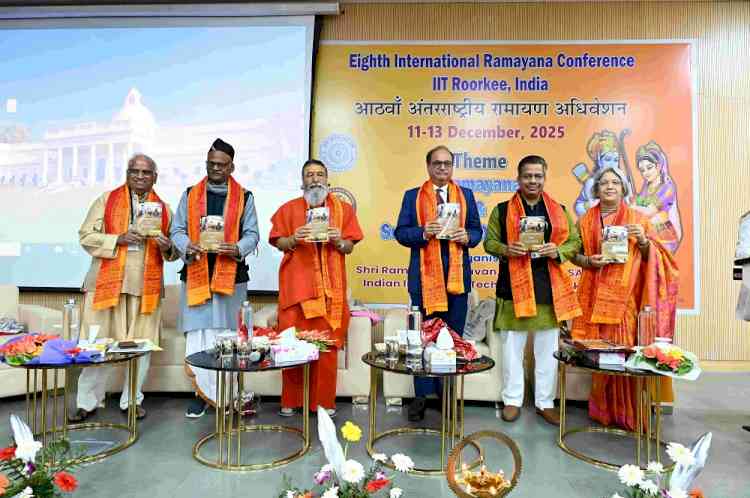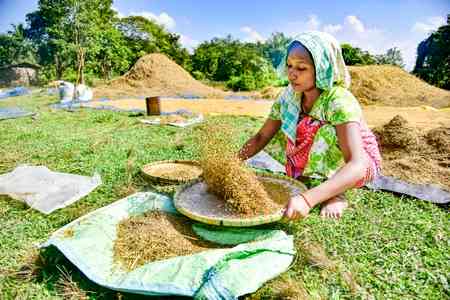Trans-Himalayan regions in Himachal home to 83 snow leopards: Study
The trans-Himalayan ecosystem in Himachal is home to wide-roaming 83 snow leopards, an iconic species often referred to as the "Ghost of the Mountain", a major rise from 51 as per the previous assessment in 2021.

Vishal Gulati
Shimla, Nov 2 (IANS) The trans-Himalayan ecosystem in Himachal is home to wide-roaming 83 snow leopards, an iconic species often referred to as the "Ghost of the Mountain", a major rise from 51 as per the previous assessment in 2021.
The second round of snow leopard population assessment, conducted by the state Wildlife Wing in collaboration with the Nature Conservation Foundation from 2024-25 in 26,000 sq km of the snow leopard habitat dotted across rugged mountains and precipitous valleys with limited accessibility during winter, indicates its density ranged from 0.16 to 0.53 individuals per 100 sq km.
The trans-Himalayan regions of the upper Spiti landscape and Pin, both in the Lahaul-Spiti district, recorded the highest densities of snow leopards, with the region of Kinnaur and Tabo being the regions with high densities.
Lahaul-Pangi and the Great Himalayan National Park (GHNP), a UNESCO World Heritage Site, were regions with lower densities.
The derived density of snow leopards across the state was 0.35 (0.23-0.53) individuals per 100 sq km with an estimated sigma of 5.2 (4.7-5.8) km.
Besides Himachal, the snow leopard is also found across Jammu and Kashmir, Ladakh, Uttarakhand, Sikkim, and Arunachal Pradesh.
The Hemis-Spiti landscape has been identified as one of the 20 landscapes to secure healthy populations of snow leopards across the cat’s range. Himachal Pradesh is home to unique high-altitude wildlife that includes the blue sheep, ibex and Himalayan musk deer, the prey species of the snow leopard.
The other notable mammals in the snow leopard habitat are the brown bear, the common leopard, the red fox, the stone marten, the mountain weasel, and the yellow-throated marten.
The study, "Status of Snow Leopard and Prey in Himachal Pradesh", recorded 44 snow leopards on 262 independent detections. From this dataset of 44 individuals, the researchers estimate that the snow leopard population size is likely to be 83 (67-103) individuals.
Across the low strata region (Lahaul-Pangi and GHNP), they estimate 24 (19-30) individuals and across the high strata region (upper Spiti landscape and Kinnaur), they estimate 59 (48-73) individuals.
Camera trapping surveys not only collected data on the snow leopard but also captured the Pallas’s Cat in Kinnaur, a species that had never been officially recorded before, and the woolly flying squirrel, whose occurrence in the state was unknown for several decades.
Locals were engaged in fieldwork for the camera trapping exercise. At least 23 people from the snow leopard landscape were involved in the survey. They were adequately supported by NCF researchers, the frontline staff of the state Wildlife Wing and other villagers.
The women’s involvement in camera trapping went far beyond just setting up the devices. They demonstrated remarkable skill in analysing the images that the cameras captured, says the study. The women from Kibber, through their training and determination, proved that with the right support and resources, local communities, particularly the women, can play a transformative role in biodiversity conservation.
The report says the second round of population estimation estimated 83 individuals, compared to an estimate of 51 snow leopards in the first round that ended in 2021. Also, the researchers spotted cubs in several areas, indicating the presence of breeding individuals.
The snow leopards were also recorded either as resident individuals of a population or as dispersing individuals navigating through these connecting habitats.
The report says that while the snow leopard numbers are not decreasing in Himachal Pradesh, they still face significant threats to their population. From attempted retaliatory measures due to their livestock depredation behaviour, to loss of habitat to ill-planned development projects, there is still a need for active and innovative conservation interventions.
The researchers point out a worrying trend of increased presence and impact of free-ranging dogs across snow leopard habitat. The dogs are known to transmit diseases to snow leopards, kill wildlife, including the key prey species of snow leopards, and chase snow leopards from their kills.
Both assessments produced the knowledge that sets a strong foundation on which to build up better understanding of the motivations and views of local communities, who must remain central to all conservation efforts of the snow leopard.
The state released its first comprehensive report on the snow leopard population survey in 2021, marking India’s first state-wide assessment of the species twice.
(Vishal Gulati can be contacted at [email protected])
--IANS
vg/vd


 IANS
IANS 











